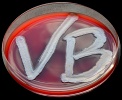| Species/Subspecies: | Clostridium haemolyticum | ||||||||
|---|---|---|---|---|---|---|---|---|---|
| Categories: | Causes hemolysis; spore forming; motile | ||||||||
| Etymology: | Genus name: a small spindle. Species epithet: blood-dissolving, hemolytic. | ||||||||
| Significance: | Is not important in Sweden, but in the USA and in South America. [Of minor importance] |
||||||||
| Alternative Species Name(s): | Clostridium novyi typ D | ||||||||
| Taxonomy: | Class Clostridia Order Clostridiales Family Clostridiaceae Genus Clostridium |
||||||||
| Type Strain: | ATCC 9650 = NCTC 13022 | ||||||||
| Macromorphology (smell):
| Form small colonies (1-3 mm i diameter), which can easily float together to form a continuous carpet on the plate (the bacteria "swarm"). Give strong hemolysis on blood agar. | ||||||||
| Micromorphology: | Large motile rods (0.6-1.6 x 1.9-17.3 µm), which have peritrichous flagella. Form oval subterminal spores, which result in swollen cells. | ||||||||
| Gram +/Gram -: | G+, but it is difficult to get good result upon gram staining of old cultures. | ||||||||
| Metabolism: | Anaerobic | ||||||||
| Catalase/Oxidase: | -/ | ||||||||
| Other Enzymes: | Esculinase -, lecithinase +, tryptophanase + | ||||||||
| Fermentation of carbohydrates: | D-glucose ? lactose - maltose (-) L-rhamnose (-) sucrose - L-arabinose - cellobiose - D-mannitol - salicin - trehalose (-) glycerol ? inulin - raffinose (-) D-sorbitol - starch - |
||||||||
| Spec. Char.: | Optimal growth temperature: 37°C. | ||||||||
| Special Media: | |||||||||
| Disease: | Bacillary haemoglobinuria in cattle (= redwater). |
||||||||
| Hosts: | Cattle and other ruminants | ||||||||
| Clinical Picture: | Abdominal pain, anemia, dehydration, fever. | ||||||||
| 16S rRNA Seq.: |
| ||||||||
| Taxonomy/phylogeny:
|
About 180 differens species have been descibed within genus Clostridium. C. haemolyticum is very closely related (phylogenetically) to C. botulinum group III and C. novyi. | ||||||||
| Updated: | 2023-03-08 |
